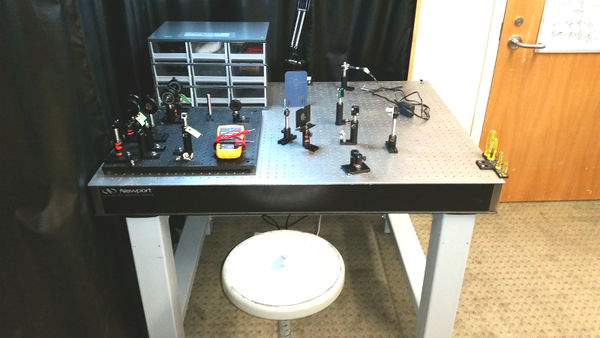Difference between revisions of "Optics Obstacle Course"
| Line 26: | Line 26: | ||
# Use mirrors to pass beam through two irises (or two beam alignment cards), aligned along a row of holes on the table | # Use mirrors to pass beam through two irises (or two beam alignment cards), aligned along a row of holes on the table | ||
# Measure the power of the beam using the photodetector and an oscilloscope. Is the light polarized? If not, polarize it, aligning the axis of polarization vertically | # Measure the power of the beam using the photodetector and an oscilloscope. Is the light polarized? If not, polarize it, aligning the axis of polarization vertically | ||
| − | ## Measure the Optical Density (OD) of the blue laser goggles at the HeNe wavelength <math>P_{out}=P_{in}\,10^{-OD}</math> | + | ## Measure the Optical Density (OD) of the blue laser goggles at the HeNe wavelength <br><math>P_{out}=P_{in}\,10^{-OD}</math> |
#Build a 1:2 telescope to expand the beam | #Build a 1:2 telescope to expand the beam | ||
## Draw a simple ray diagram to estimate the magnification you expect for the two supplied lenses | ## Draw a simple ray diagram to estimate the magnification you expect for the two supplied lenses | ||
Revision as of 10:40, 21 January 2015
Permanent Materials (should all be present on table):
- Optics cleaning materials
- Helium Neon laser
- 4 mirrors
- Telescope lens pair (Newport KPX.097 and KPX.085)
- 3 irises and a pinhole
- Quarter waveplate @633
- Half waveplate @ 633
- Thorlabs DET110 photodetector
- Various optomechanics (mirror mounts, lens holders, baseplates, etc)
- Beam block/alignment tools
- Mystery optic
Materials to borrow when necessary
- Oscilloscope
- Chopper
- Power meter
- Extra optics as needed
Activities
(Appropriately clean all optics before use: See ebook and/or ask the instructor/TA for help)
- Read laser safety, optics common sense info (chapter 1 of the ebook "Laboratory Optics - A Practical Guide To working in an Optics Lab").
Throughout this exercise, please make an effort to never allow the laser or any reflection/retroreflection leave the boundary of the optical table - Use two mirrors to set the beam height to a level 4” above optical table
- Use mirrors to pass beam through two irises (or two beam alignment cards), aligned along a row of holes on the table
- Measure the power of the beam using the photodetector and an oscilloscope. Is the light polarized? If not, polarize it, aligning the axis of polarization vertically
- Measure the Optical Density (OD) of the blue laser goggles at the HeNe wavelength
- Measure the Optical Density (OD) of the blue laser goggles at the HeNe wavelength
- Build a 1:2 telescope to expand the beam
- Draw a simple ray diagram to estimate the magnification you expect for the two supplied lenses
- Be sure to position the lenses so the beam is centered (hint: you should do this by observing the output beam location, not merely by eyeballing where the beam hits the lens)
- Ensure collimation after second lens. Does the magnification match your prediction?
- Place a pinhole at the focus of the telescope. How does this affect the properties of the beam? Why does this happen?
- Direct light onto the Thorlabs DET110 detector, and measure the output voltage using an oscilloscope. What is the power of the beam?
- Focus light onto a small photodiode. Use a chopper and oscilloscope to measure the rise time of the diode. How does thIs rise time compare to a photodiode of larger area?
- Read about half and quarter waveplates before doing the following:
- How does vertically polarized light interact with the polarizing beamsplitter cube? Use the half waveplate to rotate the axis of polarization to be horizontal. Now what happens with the cube? Finally, rotate the axis of polarization to be 45 degrees from vertical
9.2. Align the axis of the quarter waveplate so that the beam is circularly polarized. How do you know it’s circular and not elliptical?

